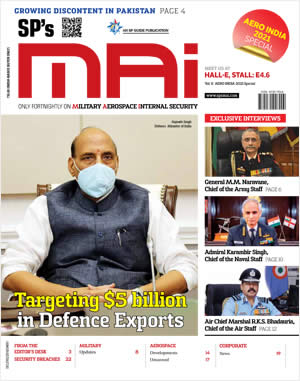INDIAN ARMED FORCES CHIEFS ON OUR RELENTLESS AND FOCUSED PUBLISHING EFFORTS

The insightful articles, inspiring narrations and analytical perspectives presented by the Editorial Team, establish an alluring connect with the reader. My compliments and best wishes to SP Guide Publications.

"Over the past 60 years, the growth of SP Guide Publications has mirrored the rising stature of Indian Navy. Its well-researched and informative magazines on Defence and Aerospace sector have served to shape an educated opinion of our military personnel, policy makers and the public alike. I wish SP's Publication team continued success, fair winds and following seas in all future endeavour!"

Since, its inception in 1964, SP Guide Publications has consistently demonstrated commitment to high-quality journalism in the aerospace and defence sectors, earning a well-deserved reputation as Asia's largest media house in this domain. I wish SP Guide Publications continued success in its pursuit of excellence.
- Indian Air Force Aims for Full Indigenous Inventory by 2047 — Air Chief Marshal A.P. Singh
- General Upendra Dwivedi takes over as the Chief of the Army Staff
- Rajnath Singh assumes charge as Defence Minister for the second consecutive term
- Admiral Dinesh K. Tripathi assumes Command of the Indian Navy as 26th Chief of the Naval Staff
- Prime Minister witnesses 'Bharat Shakti' – a Tri-Services Firing and Manoeuvre Exercise in Pokhran, Rajasthan
India's own AMCA fighter
 |
 |
 |
 |
 July 02, 2012 : With so much attention paid to India's LCA Tejas and the Indo-Russian Fifth Generation Fighter Aircraft (FGFA - but officially designated Prospective Multi-role Fighter or PMF) programme, it is important to remember that the DRDO is also designing and developing India's own next generation medium fighter, the AMCA, a stealthy twin-engined strike fighter that is intended to be an Indian take on the F-22 Raptor. July 02, 2012 : With so much attention paid to India's LCA Tejas and the Indo-Russian Fifth Generation Fighter Aircraft (FGFA - but officially designated Prospective Multi-role Fighter or PMF) programme, it is important to remember that the DRDO is also designing and developing India's own next generation medium fighter, the AMCA, a stealthy twin-engined strike fighter that is intended to be an Indian take on the F-22 Raptor.
The computer design images above, from the Advanced Projects & Technologies (AP&T) Directorate of India's Aeronautical Development Agency (ADA) provide valuable impressions on the stealth design elements that are known to be going into India's advanced medium combat aircraft (AMCA). Serpentine air intakes (with minimum flow distortion and robust pressure recovery) and internal weapons bays, depicted in the images above, are some of the most critical nose-on low observability design elements going into the programme. As part of the multidisciplinary design optimisation (MDO) currently on for the AMCA—a wind tunnel model of which was first publicly displayed at AeroIndia 2009—that design-based stealth features will include further optimised airframe shaping, edge matching, body conforming antennae and a low IR signature through nozzle design, engine bay cooling and work on reduced exhaust temperature. Radar absorbent materials and paints, special coatings for polycarbonate canopy and precision manufacturing will all be part of the effort to make the AMCA India's first stealth airplane. With aerodynamic design optimisation near complete, the AMCA's broad specifications are final. The aicraft will have a weight of 16-18 tonnes [16-18 tons with 2-tons of internal weapons and four-tonnes of internal fuel with a combat ceiling of 15-km, max speed of 1.8-Mach at 11-km. The AMCA will be powered by 2 x 90KN engines with vectored nozzles—likely to be the new GTRE-Snecma engine under development. |





